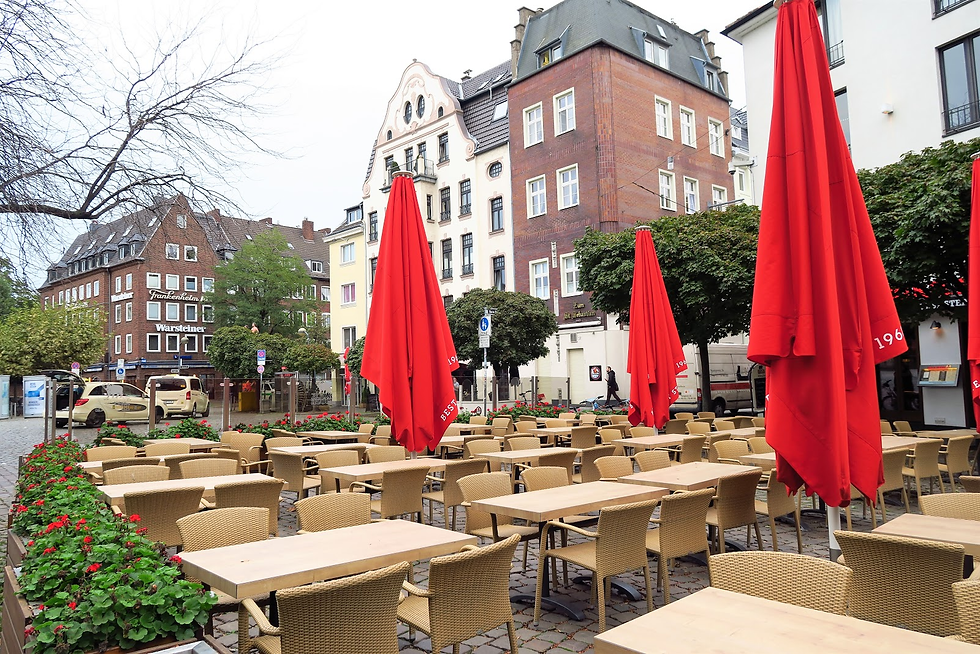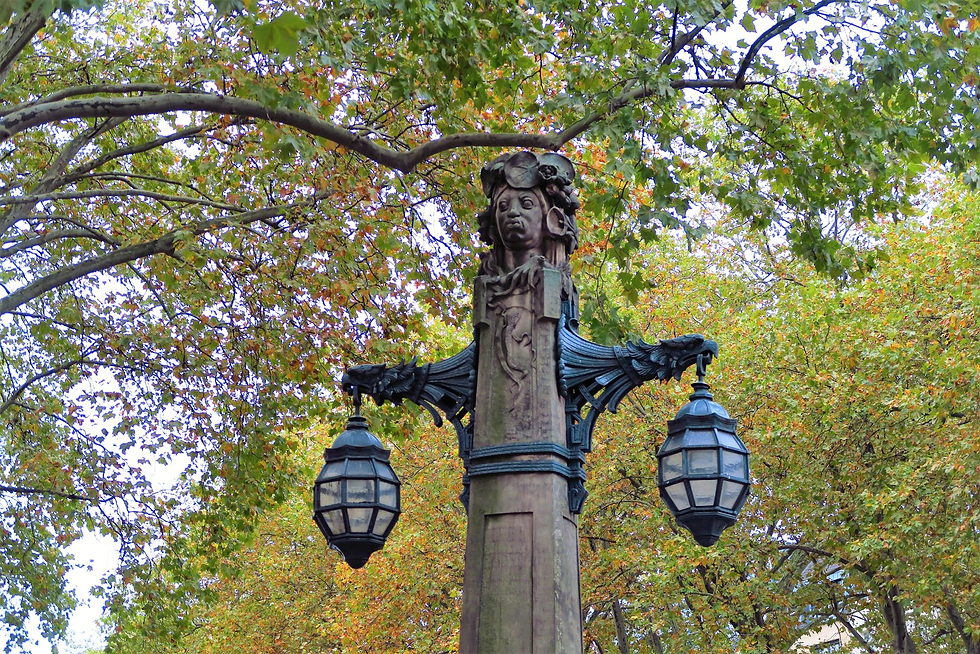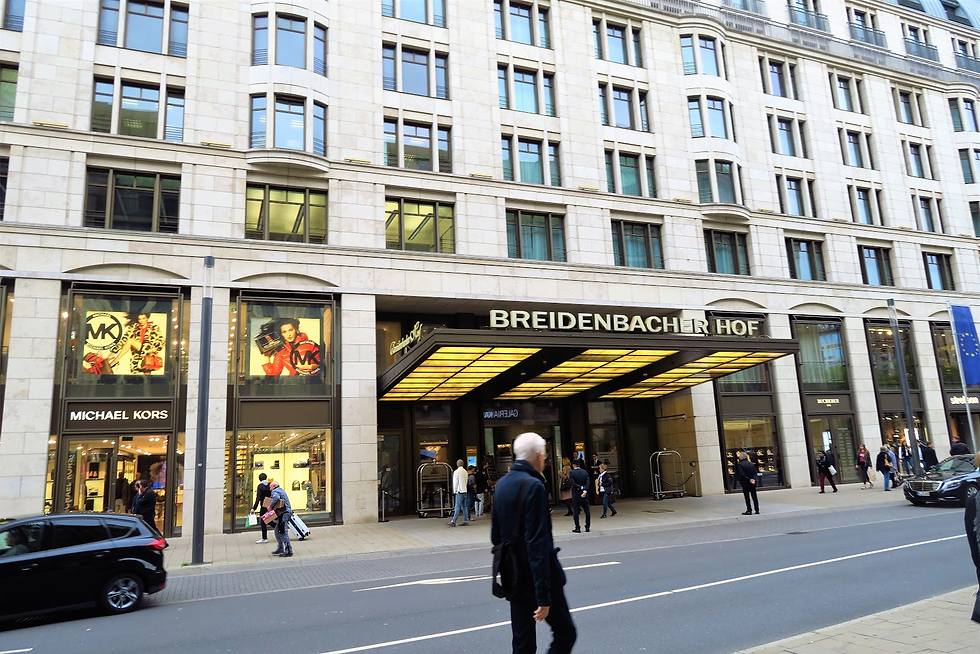Travel to Düsseldorf, Germany
- AbouTravel.

- May 15, 2022
- 4 min read
Updated: Jul 17, 2022
Düsseldorf is the capital and second-largest city (after Cologne) of North Rhine-Westphalia federal state, with a population of 617,280 residents.
Located on the banks of the Rhine River, Düsseldorf is a regional economic, financial and cultural center.
The beautiful city impresses with elegance and style and has a wide range of activities to offer - from museums, art and culture to high-end shopping, sightseeing, going out and dining at numerous restaurants spread across the city.

Here are some of the main attractions Düsseldorf is famous with:
Königsallee
Proclaimed as Germany's most elegant avenue, Königsallee is located right in the center of the city, at the two sides of a canal, stretching from Graf-Adolf Platz in the south to Triton fountain and Hofgarten in the north.
Called by locals as the “Kö”, the famous boulevard is lined with big trees and is home to many luxury and upscale brands and designer stores such as Chanel, Cartier, Tiffany & Co, Burberry, Gucci, Louis Vuitton, Hugo Boss and Prada.
You will also find here many elegant restaurants, cafes, and art galleries, that make Königsallee a great place for every visitor to soak up the affluent ambiance, while strolling along the street.




Old Town (Altstadt)
Düsseldorf's Old Town is a place you can't miss to visit. Relatively small, only half a square kilometer, the lively area offers around 260 pubs and bars and is dubbed “the longest bar in the world”. Here you can enjoy a glass of traditional Altbier while hanging out with friends.
Highlights of the Old town are several historical and cultural attractions:
Marktplatz with the imposing Town Hall (Rathaus) and the equestrian statue of Elector Jan-Wellem on its horse, erected in 1711;
The Castle tower (Schlossturm) in Burgplatz, that houses the Schiffahrts museum (Maritime museum), one of Germany's best and oldest marine museums that focuses on the history of shipping and navigation along the Rhine River;
The St.-Lambertus-Basilika - an impressive Gothic church, one of the oldest buildings in Düsseldorf.
Those interested in art and culture can visit the North Rhine-Westphalia Art Collection (Kunstsammlung Nordrhein-Westfalen) which is divided into two main venues, the K20 and K21.
The largest collection K20 is housed in a remarkable polished black granite building located on Grabbeplatz and it offers 20th-century art with works of Paul Klee, Kandinsky, Franz Marc, Ernst-Ludwig Kirchner, Picasso, Braque, and many more. The K21 Ständehaus is a separate museum introduced in 2002 and occupies the Neo-Renaissance parliament building. It features installations, prints, video art and photography by artists like Candida Höfer, Marcel Broodthaers, Paul McCarthy, Eija-Liisa Ahtila, William Kentridge and Nam June Paik. Other highlights you can see are the Filmmuseum and the Tohnhalle, Düsseldorf's concert hall, located in the northern part of the Old town.






The Rhine Embankment Promenade
Another iconic place worth visiting is the Rhine Embankment Promenade (Rheinuferpromenade).
The beautiful promenade stretches for a one-and-a-half kilometer and connects the Old town to the Rhine river.
It's a great place where you can enjoy gorgeous views and a large variety of restaurants (due to its proximity to the Old town). You can also rent a bike or take a relaxing walk along the promenade while soaking up the sun and watching the ships go by.
You may also take a cruise on the Rhine. All boat tours start from the Rhine promenade.


Medienhafen & Rhine Tower
At the southern end of the Rhine promenade are the Rhine Tower (Rheinturm) and Medienhafen ( Media harbor).
The former abandoned harbor area is now a highlight for tourists. Since the 1990s the harbor has been transformed into a contemporary office district for fashion brands and media firms.
The star architect Frank O. Gehry created a real Düsseldorf landmark with the three-part, organically designed building ensemble Neuer Zollhof.
The Medienhafen is now home to more than 700 companies and some of the best and most popular restaurants in the city.
The Rhine Tower (Rheinturm), constructed in 1981 is the tallest building in Düsseldorf, climbing to 240 meters.
The telecommunication tower has an observation deck from where you can enjoy splendid views over the city. There is an entrance fee between 5-9 euros.



Kö-Bogen
Kö-Bogen is a spectacular modern extension of the Königsallee, located at its northern corner towards Hofgarten.
Since its opening in autumn 2013, the architectural gem, designed by Daniel Libeskind turned into
Düsseldorf’s most exclusive area where international trends by renowned top brands have their offices - the Breuninger department store, Tesla, the Apple Store, and more.
The large-scale office and retail complex features an amazing convex and concave curved façade and comprises two structures, one to the east, the other to the west, separated on the ground by a central pedestrian passageway and joined above by a two-story bridge.
A must visit place while you are in Düsseldorf.



Hofgarten & Nordpark
Located in the northern part of the city center, Hofgarten is a beautiful 28 hectares park, established back in 1769.
The green lung of the Rhine metropolis is Germany's first and oldest Volksgarten and is designed in English landscape design.
The park includes extensive meadows, numerous ponds, art objects and monuments. The modern architecture of Kö-Bogen in the background adds to the experience.
While relaxing in the greenery, you can also enjoy watching a number of bird species flocking around.
Further, in the north direction you will find the other city's green park - Nordpark, which offers large walkways, inviting meadows, fountains, as well as several theme parks, with the Japanese garden being the most popular one.




German Opera on the Rhine
The Deutsche Oper am Rhein is a joint company that links the opera houses of Düsseldorf and Duisburg.
Founded in 1956, it is one of the most important opera houses in Germany.
Over 50 experienced and internationally renowned singers are part of the soloist ensemble, which is the largest in the country.
The opera also has an associated classical ballet company. The resident orchestra, the Düsseldorfer Symphoniker, plays both opera and symphonic repertoire.
The auditorium contained a parquet level, 2 levels of seating plus a gallery, providing a total of 1,260 seats.

Benrath Palace
Located southeast of Düsseldorf, Benrath Palace is one of the major attractions of Düsseldorf.
It is a magnificent Baroque-style summer residence and hunting lodge built for the Elector Palatine Charles Theodor and his wife, Countess Palatine Elisabeth Auguste of Sulzbach. Construction began in 1755 and was completed in 1770.
The palace is surrounded by 60-hectare perfectly manicured gardens with beautiful ponds, sculptures and curving paths, that invite visitors to unwind and relax.



























































Comentários